The United States is home to a vast array of snakes, both venomous and nonvenomous. Nowhere is this more true than in the southern half of the country. Snakes of the south range from tiny earth snakes all the way up to enormous Burmese pythons. Here, we’ll discover ten of the most interesting snakes of the south, some of which have a bite deadly enough to kill an adult human.
Keep reading to learn more about ten snakes that call the southern United States home!
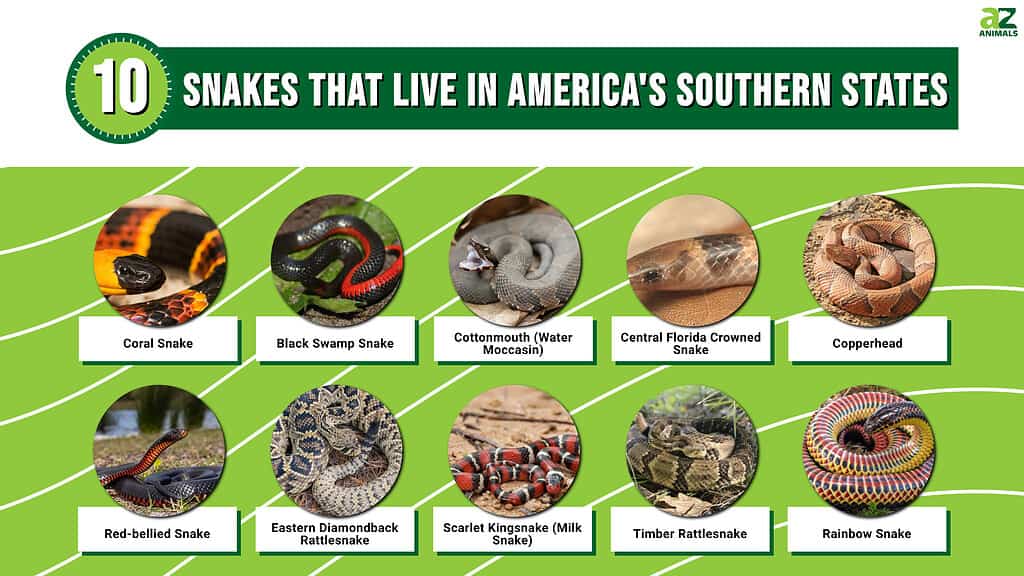
10. Rainbow Snake
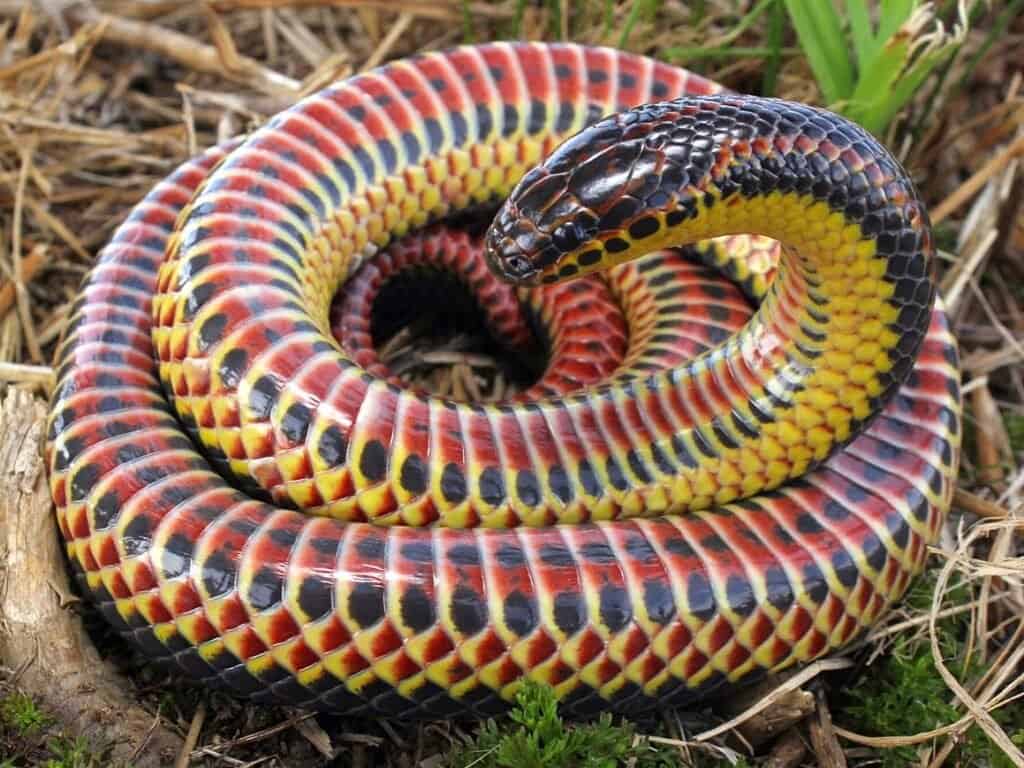
Rainbow snakes are some of the most colorful snakes in the United States.
©Charles Baker / CC BY-SA 4.0 – License
Rainbow snakes of the south grow up to five feet long. They have medium-heavy bodies, with narrow heads. They get their name from their highly colorful appearance, particularly on their bellies. Unfortunately, humans almost never get to see rainbow snakes, as they spend much of their time in the water, and tend to hide from humans. These snakes have black bodies with red and yellow stripes running from head to tail. Their bellies are multicolored white, yellow, pink, and red. They eat primarily eels.
9. Timber Rattlesnake
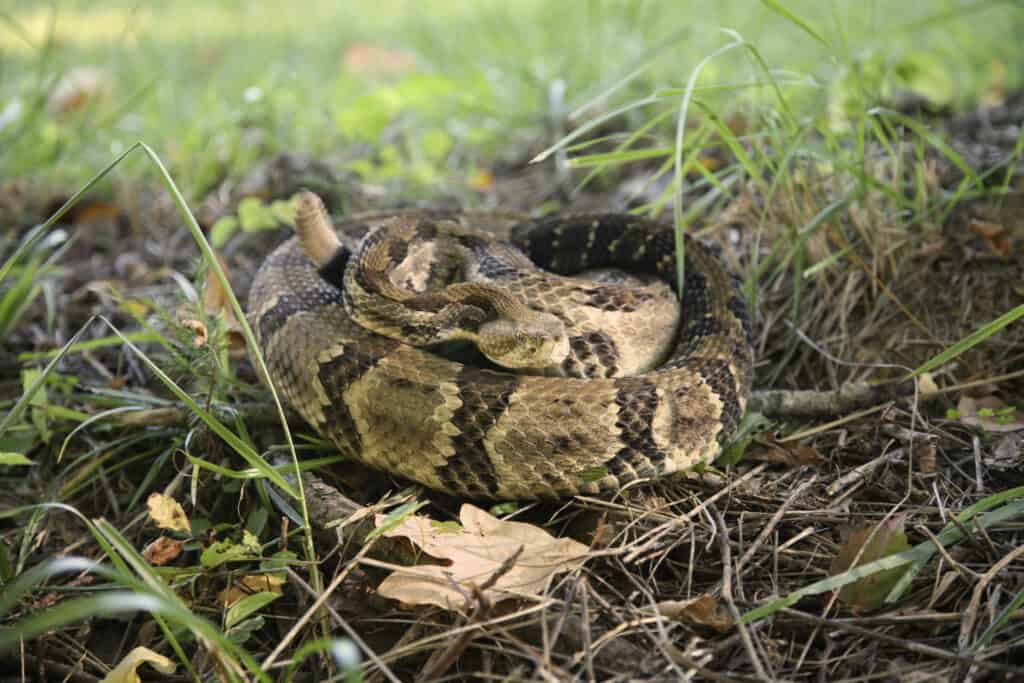
Common throughout much of the United States, timber rattlesnakes have a limited range in Florida.
©iStock.com/NajaShots
Timber rattlesnakes, also known as canebrake rattlesnakes grow up to five feet long. They have cream-colored bodies with narrow, dark brown, geometric bands. Like all rattlesnakes, they have rattles and hinged fangs. Canebrake rattlesnakes are highly venomous, and should not be approached, handled, or harassed in any way. They eat small mammals like mice, rats, and rabbits.
8. Scarlet Kingsnake (Milk Snake)

Milk snakes are common throughout much of the United States, including Florida and the Great Lakes.
©iStock.com/JasonOndreicka
Scarlet kingsnakes grow up to 30 inches long and have slender bodies with narrow heads. Milk snakes and scarlet kingsnakes are two subspecies of the same snake. Each has a different coloring. Scarlet kingsnakes are bright red, with yellow and black stripes. Milk snakes are cream-colored, with brown splotches ringed with black. Neither subspecies is venomous. They eat mostly lizards, like anoles and skinks, as well as rodents and other snakes.
7. Eastern Diamondback Rattlesnake

While western diamondback rattlesnakes are found in the southwestern United States, eastern diamondbacks rule the southeastern region.
©Chase D’animulls/Shutterstock.com
Eastern diamondback rattlesnakes of the south are large and dangerous. They grow up to eight feet long and have one of the deadliest bites in North America. These snakes have the characteristic diamond-like pattern of rattlesnakes. They are made up of scales of almost every shade of brown. These snakes live in thickly vegetated areas, where they hunt small mammals, like rats, rabbits, and mice. Despite their deadly bite, eastern diamondback rattlesnakes only bite as a last means of self-defense.
6. Red-bellied Snake

These snakes are common throughout the eastern half of the United States, with the exception of the Florida panhandle.
©Ken Griffiths/Shutterstock.com
Red-bellied snakes of the south are tiny, growing only up to ten inches long. They may be black with red bellies, all over brown, gray, or even brown with an orange stripe. They’re nonvenomous and live in many suburban and forested areas. Red-bellied snakes eat insects, slugs, and worms. When threatened, they curl their lips up to show their teeth.
5. Copperhead
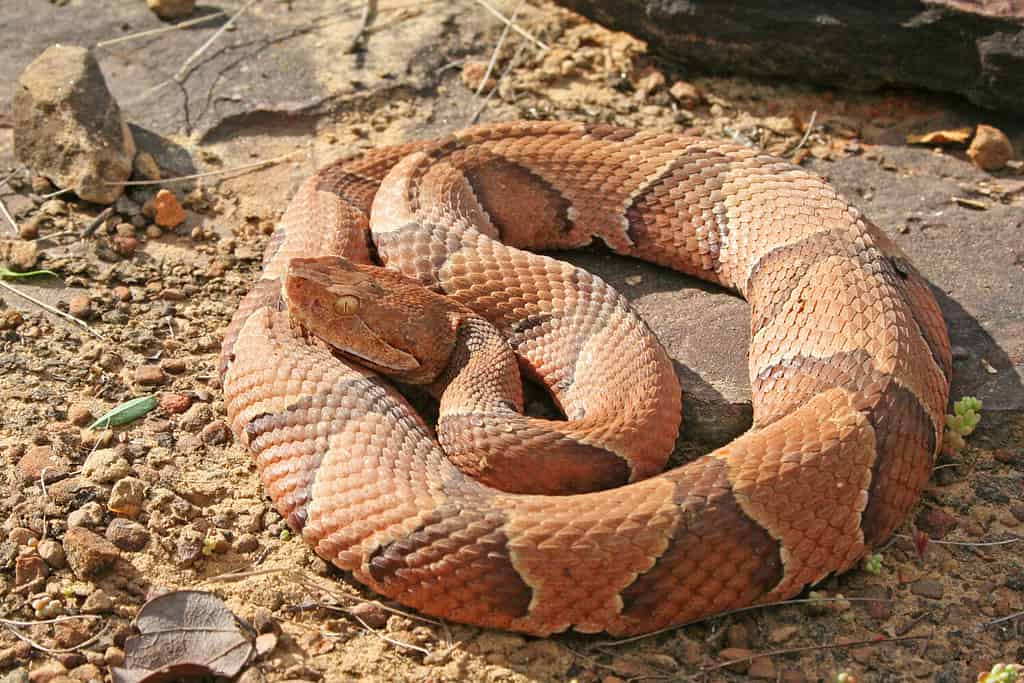
One of the most widespread snakes in North America, the copperhead is absent from the Great Lakes and most of Florida.
©Creeping Things/Shutterstock.com
Copperhead snakes of the south grow up to 40 inches long. They have venomous bites, though they’ve never been responsible for a human fatality. These snakes are light brown with characteristic hourglass-shaped dark brown bands. They have medium-heavy bodies, with triangular heads and vertically elliptical pupils. Copperheads often hide under buildings, near building debris, or beneath bushes or other vegetation. They mainly eat small mammals, like mice, gophers, and rats.
4. Central Florida Crowned Snake
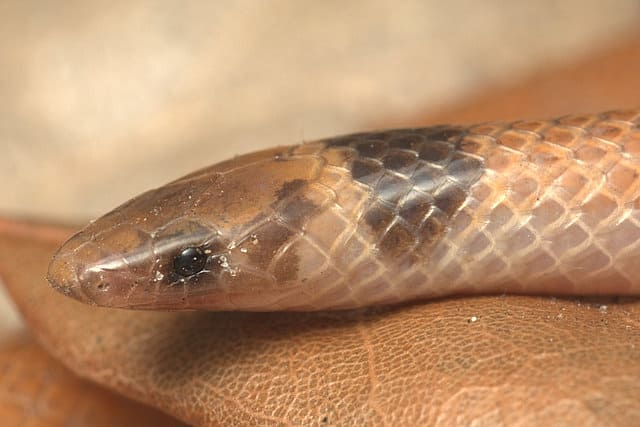
This snake of the south has one of the smallest ranges of all North American snakes.
©Alessandro Catenazzi / Creative Commons – License
Central Florida crowned snakes are tiny, with adults growing only to nine inches long. They only live in certain parts of central and eastern Florida. These snakes are very pale in color, with jet-black heads. They’re fossorial, which means they spend most of their time underground. Central Florida crowned snakes eat mostly insects, like worms. They’re nonvenomous and rarely seen by people.
3. Cottonmouth (Water Moccasin)
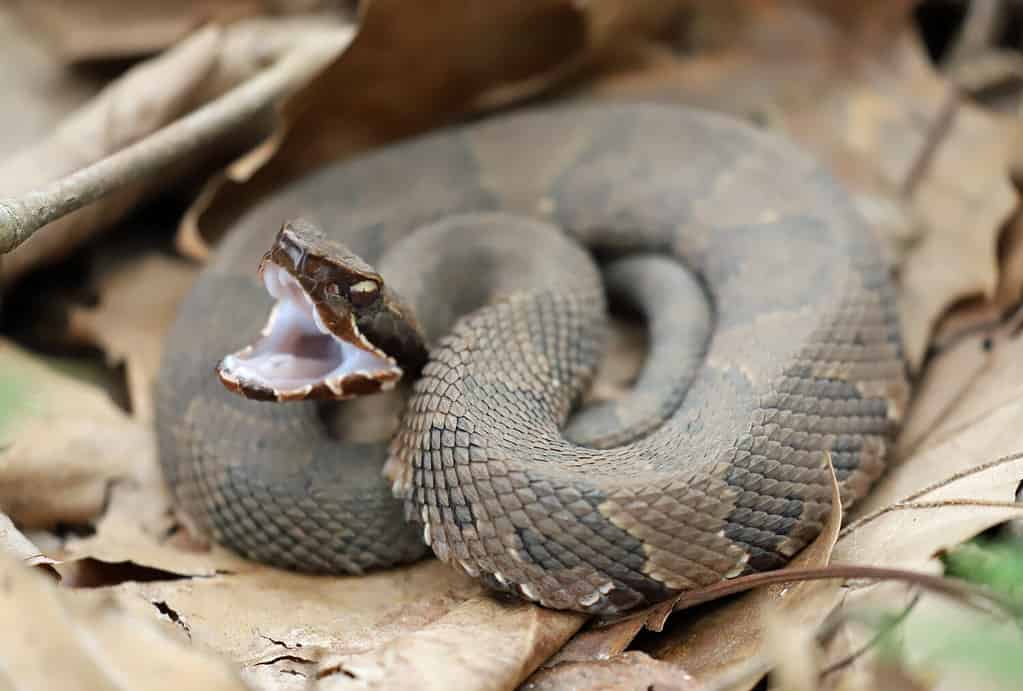
One of the most infamous snakes of the south, the cottonmouth gets its name from the cottony white inside of its mouth.
©KF2017/Shutterstock.com
Cottonmouths are highly venomous members of the pit viper family. They have broad, triangular heads with large venom glands, vertically elliptical pupils (like a cat’s eyes), and fangs. They’re typically dusky brown or gray, with darker hexagonal bands. Cottonmouths grow up to four feet long. They’re known to aggressively stand their ground when humans threaten or approach them. They eat a wide variety of prey, including baby alligators, baby turtles, birds, frogs, lizards, snakes, and small mammals.
2. Black Swamp Snake
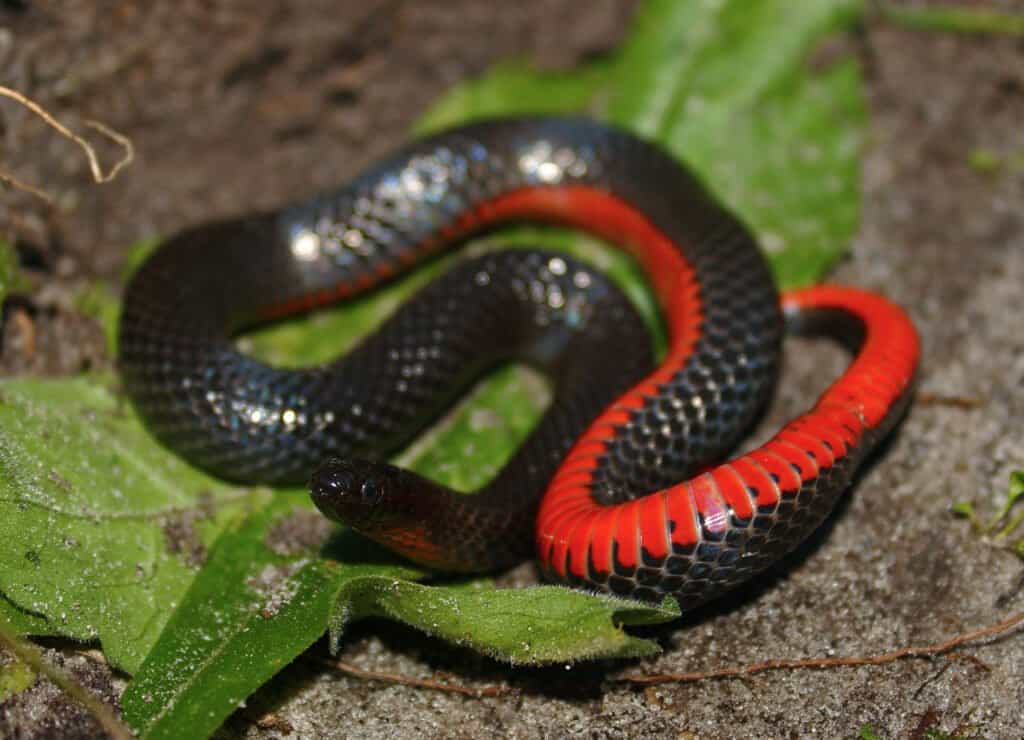
At birth, black swamp snakes are only 2-3 inches long.
©Peter Paplanus / flickr – License
Black swamp snakes of the south grow up to 22 inches long. They have heavy bodies with narrow heads and black eyes. Their backs and sides are dark brown or black, while their bellies are bright red and lack markings. They live in the southeastern United States, where they spend most of their time in the water. These snakes eat frogs, tadpoles, and small fish.
1. Coral Snake

One of the most venomous snakes of the south, the coral snake is found only in the southeastern United States.
©Patrick K. Campbell/Shutterstock.com
Coral snakes are beautiful and deadly. They live in the extreme southeastern part of North America. These snakes grow up to four feet long, with narrow bodies and head the same width as their bodies. They’re black, with narrow yellow stripes bordering thicker red stripes. Despite their lethal bite, coral snakes are shy and rarely encountered by humans. They eat mostly other snakes and lizards, and live on the ground, near freshwater.
Summary of 10 Snakes That Live in American’s Southern States
| Snake | Venomous | |
|---|---|---|
| 1 | Coral Snake | X |
| 2 | Black Swamp Snake | |
| 3 | Cottonmouth (Water Moccasin) | X |
| 4 | Central Florida Crowned Snake | |
| 5 | Copperhead | X |
| 6 | Red-bellied Snake | |
| 7 | Eastern Diamondback Rattlesnake | X |
| 8 | Scarlet Kingsnake (Milk Snake) | |
| 9 | Timber Rattlesnake | X |
| 10 | Rainbow Snake |
The photo featured at the top of this post is © Scott Delony/Shutterstock.com
Discover the "Monster" Snake 5X Bigger than an Anaconda
Every day A-Z Animals sends out some of the most incredible facts in the world from our free newsletter. Want to discover the 10 most beautiful snakes in the world, a "snake island" where you're never more than 3 feet from danger, or a "monster" snake 5X larger than an anaconda? Then sign up right now and you'll start receiving our daily newsletter absolutely free.
Thank you for reading! Have some feedback for us? Contact the AZ Animals editorial team.







